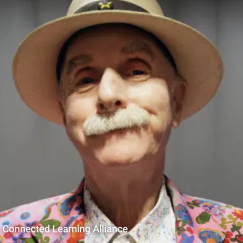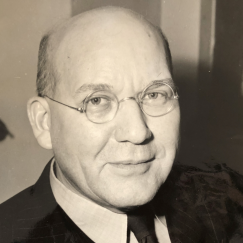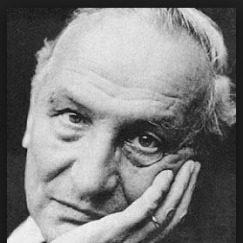Remember that values questions have a “you” in them. The goal is to involve people in relating what they see on the screen to their own lives, not to analyze the filmmaker’s technique or to engage in intellectual criticism. Allow the conversation to flow along a values and feelings track.
Bio/Short Description
Anything written in this little box would pale in comparison to the encyclopedia that is http://www.bobolinkbooks.com/Arnheim/Home.html but nonetheless... Arnheim was born just after the turn of the last century, to a Jewish family in Germany. He discovered Freud during his teen years, which inspired him to study psychology. His PhD at Berlin University concerned what might be classified under "audience studies" today. He reviewed films for a newspaper until his first book Film as Art was banned by the Nazis. Thereafter he fled fascism by way of Italy, the UK and finally the US. His American research in visual perception was underwritten by major fellowships, and he went on to develop theories of cognition and visual-spatial ability. Upon retirement from Harvard, he became a visiting professor in Michigan. He was involved with the American Psychological Association and the American Academy of Arts and Sciences until his death at 102 in 2007. Photo: shallwemeanderon.blogspot.com
HOW THEY INFLUENCED YOU?
External Links
Other Grandparents
 ColinPosted By: Renee HobbsOn:07/13/2025 - 00:50
ColinPosted By: Renee HobbsOn:07/13/2025 - 00:50
 BillPosted By: Renee HobbsOn:06/29/2025 - 20:45
BillPosted By: Renee HobbsOn:06/29/2025 - 20:45
 HowardPosted By: Renee HobbsOn:01/27/2024 - 22:47
HowardPosted By: Renee HobbsOn:01/27/2024 - 22:47
 Gary Posted By: Renee HobbsOn:01/01/2024 - 00:39
Gary Posted By: Renee HobbsOn:01/01/2024 - 00:39
 Clyde Posted By: Renee HobbsOn:04/04/2023 - 18:16
Clyde Posted By: Renee HobbsOn:04/04/2023 - 18:16



Renee Hobbs
Arnhem offered a large lecture course in visual thinking (art and perception) when I was a undergraduate at the University of Michigan and I remember loving his many ideas about gestalt, figure-ground and the psychology of color. But it was the book, Film as Art that really floored me when I was first trying to understand the early history of film in relation to media literacy. While at Harvard, I learned that Arnheim was following in the footsteps of Hugo Munsterberg, whose 1908 book, The Photoplay, explored the psychology and pleasures and aesthetics of film viewing. How fascinating that these German intellectuals helped us see the powerful interplay and depth embedded in the relationship between artist and interpreter.
Jennifer Swift-Kramer
Having found media studies after formal training in fine art, I was often at a loss to make myself understood in the humanities. My only "translator" was Rudolf Arnheim. Cinema Studies 101 assigned Film As Art, but my favorite book of his was the comparatively new Visual Thinking. As his preface put it, "artistic activity is a form of reasoning, in which perceiving and thinking are indivisibly intertwined," a definition I understood to apply as much to consumers as creators, in physical and electronic media alike. Years later, I opened an issue of Leonardo and found a letter to the editor from him, complete with a home address! I contacted him about my academic homelessness and he was kind enough to reply. Unfortunately he admitted being out of the loop for long enough that he couldn't give me much advice, but he did invite me to lunch. I was afraid we'd have nothing to say, so I didn't take him up on his offer. (Meeting Robin Wood for the first time only to discover he was burnt out and trying to write a novel in San Francisco was one of the most depressing non-conversations I've ever had.) However, I'll always have a piece of his homemade stationery - personalized with his initials in red felt tip!